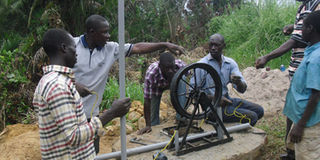Earning from water pump technologies

Mr Johnnie Wasswa (second left) directs a worker to bring one of the materials required to install the Uga water pump. PHOTO BY FAISWAL KASIRYE
What you need to know:
The innovation. Using local materials, he makes two types of pumps for people In rural areas.
Water collection in some rural areas is no longer a dreaded activity, thanks to Johnnie Wasswa’s user friendly innovations. For that, it is now possible in some rural parts of Busoga and Buganda to spend a few minutes rather than hours pumping water from bore holes or scooping it from wells as it is the practice in most rural areas.
If these innovations are embraced, it will also mean among others, that cases of children drowning in some wells or streams while collecting the much needed water will be no more.
“After seeing the hardship that our people go through to collect water, I thought I could do something about it,” said Mr Wasswa in an interview last week.
With the water pump innovations, he is now playing in a different league, unlike many young men who spend months or years looking for jobs. He says the Rope pump is simple and affordable. To purchase the material he needs for the equipment such as old car tyres, ordinary nylon, plastic materials, cement, sand, and steel materials, among others, he needs about Shs315,000. But depending on the size, labour, installation place and the design of the facility, the cost could go up. In turn, his installation cost ranges between Shs800,000 and Shs1.5 million.
“The pump is made from locally available materials. This means that the entire community should be able to benefit from it,” said Mr Wasswa. The Katwe based technician also believes that the innovation is a stark reminder of the importance of the Jua Kali (informal settings) activities—normally relegated to the lower echelons of society.
Mr Wasswa runs this registered business by the name Watcom. Going forward, he wants Watcom to be known for assisting the wider community access clean water—no matter the environment or the remotest of the place.
The Watcom improved technology has been effective in several developing countries around the world. Asia is one such continent whose countries have used the technology especially in rural settings.
The uses
The Rope pump can also be used for small-scale irrigation. It can also be installed as an underground tank. Meanwhile his other innovation— Uga pump is a low cost hand pump made out of locally available materials. The advantages of the pump are its resistance to corrosion, user friendliness (women and children below 10 years can operate it) and ease of installation, at a depth of about 10 –15m.
But, Mr Wasswa reckons that price fluctuations for the raw materials and poor maintenance practices are some of the major challenges he has got to deal with. He hopes also to refine the innovations further and he wouldn’t mind collaborating with other players such as Non-Government Organisations (NGOs) and government.
From this business, he managed to rise from a mere technician to a professional engineer. He now holds a Kyambogo University degree in building and civil engineering. With an initial capital of about Shs100,000 five years ago, the 30-year old says he is happy with what he has achieved so far, although he also strongly believes that so much is yet to be achieved.
“In a year, I sell not less than 25 pumps—both rope and Uga pumps. And with that I have supported my family, myself and I have been able to create jobs for six people.”




